Bureau of Land Management Rejects Solar Development in Silurian Valley
November 20, 2014 - Today the California State Office of the Bureau of Land management (BLM) announced it has rejected an application for a solar energy right-of-way in the Silurian Valley in San Bernardino County, California.
The statement will be posted shortly on BLM's website, and states:
The project application, submitted by a subsidiary of Iberdrola Renewables, LLC, had proposed a 200 megawatt photovoltaic solar project on 1,616 acres about 10 miles north of Baker along highway 127. The BLM determined that the solar project would not be in the public interest after undergoing a rigorous review process in accordance with the BLM's Western Solar Plan.
The Plan, approved in October 2012, created Solar Energy Zones across the West where solar energy projects would be prioritized. The Plan does allow for solar development outside of Solar Energy Zones, however applications in these variance areas must go through a review process based on required factors specified in the Plan before determining if the area is suitable for solar development.
In making its determination on the Silurian Valley project, the BLM analyzed environmental data in addition to gathering information from the public and local, state, federal and tribal governments. The initial review and analysis indicated that the impacts to the Silurian Valley, a largely undisturbed valley that supports wildlife, an important piece of the Old Spanish National Historic Trail, and recreational and scenic values, had too great of an impact on the resources. The BLM concluded that these impacts likely could not be mitigated and that the project would not be in the public interest.
The BLM has approved 18 solar, wind and geothermal projects on public lands in California since 2010. The Silurian Valley project is the first to be denied through the variance process.
California State Office 2800 Cottage Way W1613, Sacramento, CA 95825
Release Date: 11/20/14
Contacts:
Dana Wilson, (916) 978-4622, dmwilson@blm.gov
News Release No. CA-SO-15-06
Resource Agencies Comment on Silurian Solar Project Application
April 8, 2014 - The US Fish and Wildlife Service (USFWS), California Department of Fish and Wildlife (CDFW), and National Park Service (NPS) sent comment letters to the Bureau of Land Management (BLM) on their concerns with large-scale solar development in the Silurian Valley.
The USFWS stated strongly that the impacts to desert tortoise connectivity, migratory birds and golden eagles were too great and recommended BLM reject the application since it was in a variance area. Large solar panel arrays would create lake-effects that could negatively impact migrating birds, the agency commented. Saratoga Springs, playa lakes, Salt Creek Area of Critical Environmental Concern, and springs in the Kingston Range all served as stopovers for birds in the region. Birds flying into solar panels that look like water could cause deaths.
The California Department of Fish and Wildlife similarly recommended against the project in this relatively undisturbed habitat for numerous special status species. Both agencies cited the lack of surveys of many birds and rare plants, and the number of golden eagle nests in the area.
The National Park Service comment letter can be seen >>here.
Public Meeting Report
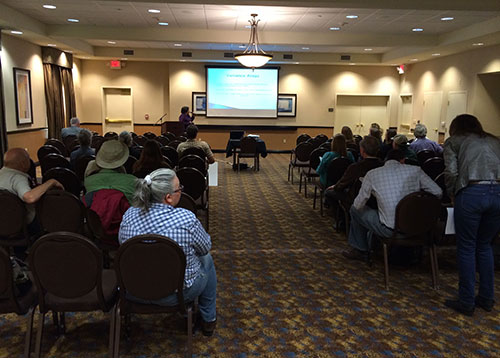
April 2, 2014 - Barstow CA - The March 27 meetings held by the Bureau of Land Management (BLM) became rowdy at times, especially in the early afternoon meeting. The Spanish company Iberdrola is seeking to build a large-scale photovoltaic and wind project in remote Silurian Valley north of Baker CA in eastern San Bernardino County.
This is the first project in the Solar Programmatic Environmental Impact Statement process undergoing a "pre-meeting" to decide whether the project should go forward in a Variance Zone, outside of the agency-preferred Solar Energy Zones.
Contention from the public reflected this, many commentors asking why the Solar PEIS process was used and so much time spent analyzing Solar Energy Zones, when BLM is allowing projects outside the zones to seek application review.
But also many in the public were upset about the degradation of the public commenting process itself. No longer was BLM recording public comments, bringing into question whether these comments really mean anything. BLM recommended to write all comments down and hand in written sheets of paper or send emails, to ensure public comments would be considered. But this leaves out a segment of the population that cannot read nor write, and people with disabilities. So far BLM has refused to record spoken public comments at recent meetings.
BLM admitted this was a low-priority application with no timeline (several months may elapse before a formal review would be started). First a decision will be made to either proceed or deny, and the BLM state director would make this decision in concurrence with the national director, who could independently deny the application.
The National Park Service, US Fish and Wildlife Service, and California Department of Fish and Wildlife wrote comment letters on the Silurian Valley project to the BLM, and we are requesting these be made public (we are still waiting for the letters to be made public).
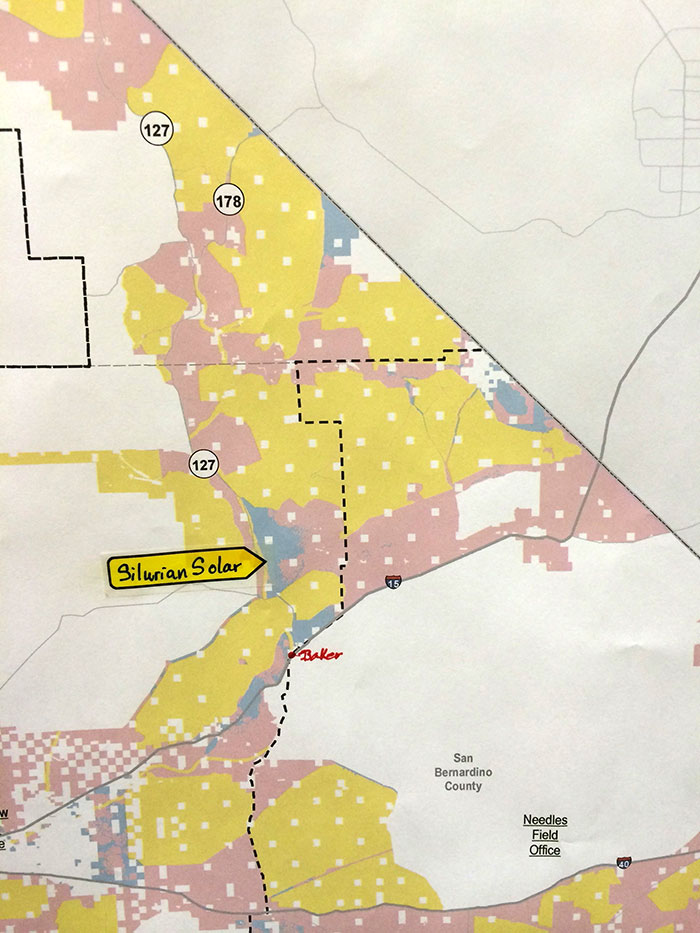
^Solar Programmatic Impact Statement map showing the solar project in blue Variance Lands. Yellow indicates BLM administered lands not available for solar development. Pink are exclusion areas.
Iberdrola the Applicant
The company placing the application for development on public land in Silurian Valley gave a presentation, saying how "We are trying to combat climate change." They said they thought the project was "very well sited" with "low environmental conflicts."
The solar project would be up to 200 megawatts on a 7,200-acre Right-o-Way. A transmission line lies one mile to the south, and the company had an interconnect request to the line owner Los Angeles Department of Water and Power; a feasibility study was in process. Iberdrola applied in 2012 and is still awaiting an answer, saying that if they moved the project to another location they would have to start over. The solar project would provide 10-12 permanent jobs.
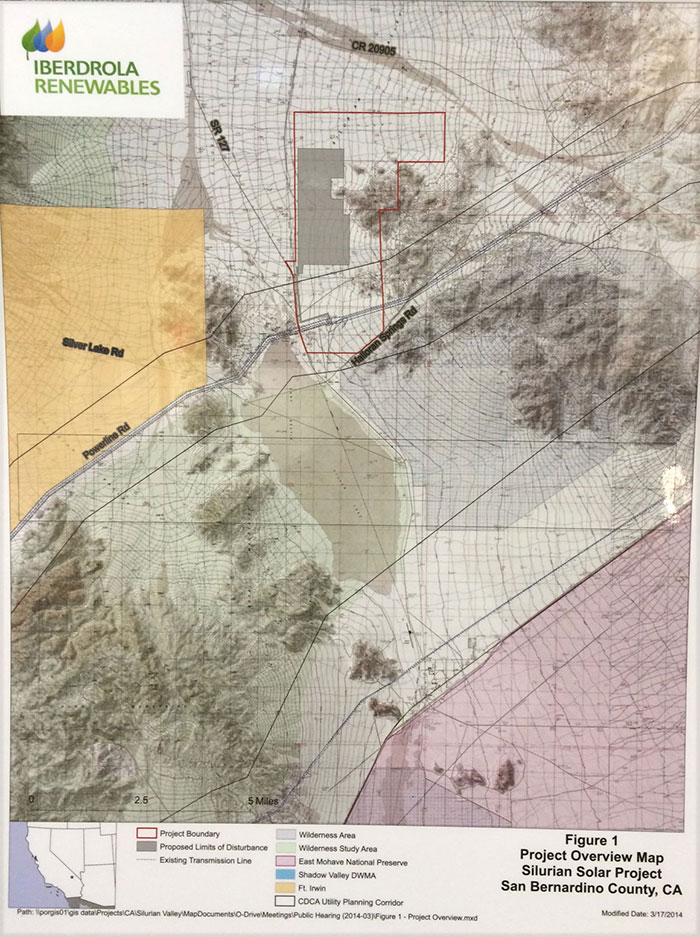
^Map of the solar project Right-of-Way and photovoltaic panel footprint.
^Detail of map.
Cultural Conflicts
Just west of the project lies the historic Tonopah and Tidewater Rail Road bed, which linked mining towns to smelters in the south. The Old Spanish Trail crosses the site as well, with a nationally protected visual resource. This trail rates with the Oregon Trail and Chisholm Trail in importance. From the 1820s to 1840s mule packers traveled the route, and left a trace. Later the Mormon Trail followed the same route after California became a state, from 1848 onward. Some Utah wagon trains veered off to southern California to avoid the infamous Donner Pass across the Sierra Nevada mountain range. The two-track wagon trail can still be seen here. The city of San Bernardino was founded by Mormons taking this road across Silurian Valley to southern California.
Public Comments
About 40 people attended each of two meetings in the early and late afternoon in Barstow, and many people made public comments (which were not recorded for the record).
Terry Weiner of the Desert Protective Council (DPC) voiced an objection to the meeting format. She decried the lack of democracy in the process whereby peoples’ comments were not going to be officially entered into the public record and suggested strongly that they change the format for the rest of the meeting whereby the public could ask their individual questions about the project from the floor so that others present would benefit from hearing the questions and the answers. The BLM said they would not change the meeting format but they would allow the group to come back as a whole in 20 minutes rather than an hour.
- This first objection to the meeting format was followed by a few minutes of increasingly rowdy loud objections to the format from the audience, with a couple of people muttering that they would walk out of the meeting. One person said he was going to go hiking.
Represented and making verbal comments at the meeting were representatives of the Baker Community Services District, the DPC, the Old Spanish Trails Association, the Film Commission, the California Wilderness Coalition, a Native American (Shoshone?). Individual speakers included Pat Flanagan, Tom Budlong, John Hiatt, Terry Frewin, Randy Banis, Chair of the BLM Desert Advisory Council and others.
Many critical impacts from this project were eloquently addressed, including the facts that the Silurian Valley is indeed a wildlife connectivity corridor, and that it is the southern gateway to Death Valley National Park and is an uncluttered wild valley between Kingston and Clark Mountains and sits between the wild Soda Mountains and Avawats Range, and that the Silurian Valley is the southern part of the wettest part of the Mojave desert. Pat Flanagan talked about the important migrating birds corridor and the eBird database logging 315 species of birds that migrate through this area.
Ileene Anderson of Center for Biological Diversity told how long-time conservationist, the late Elden Hughes called Silurian Valley the "Golden Triangle" due to its shape wedged between the Mojave National Preserve and Death Valley National Park: the area connects the two park units east of the Fort Irwin Army base. She also raised a concern about the segmentation of the solar and wind projects by the applicant. She recommended that all applications in Variance Areas be denied until Solar Energy Zones are fully utilized.
A representative of The Wilderness Society spoke about how Silurian Valley should not have renewable energy development, the valley is a critical piece of the conservation puzzle and should be upgraded in conservation status in the Desert Renewable Energy Conservation Plan (DRECP). There are wildlife corridors here. Tourists come here to see dark night skies. Solar Energy Zones, degraded lands, and rooftops should be used instead was the comment conclusion.
Nancy Good of Tecopa said she owns 120 acres in Silurian Valley, patented land. She spends a great deal of time out there taking photographs, as she is a professional photographer and on the board of the Amargosa Conservancy. She explained the Mojave Desert restores us when we come here. "This is my home, this is my heaven."
Freelance photographer Michael Gordon showed two photos he took in the Silurian Valley, saying these are national park quality lands. They are not disturbed. He pointed out that the Visual Resource management Class that the BLM assigned to the valley is "VRM Class III, indicating that the existing character of the landscape should be retained. National Geographic listed the Mojave Desert as one of the "World's Most Beautiful Places," he added.
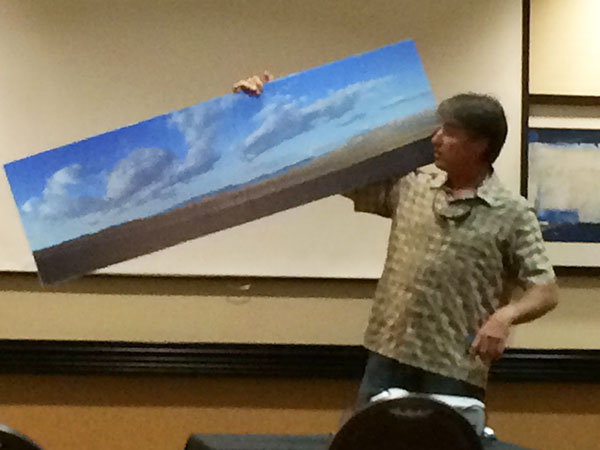
^Professional photographer Michael Gordon holds up a his photo of Silurian Valley.
Amy Noel, a business owner in Tecopa Hot Springs to the north said she was disappointed that companies come out to this pristine desert. "Why not spend two years studying how to get solar on 60,000 houses?"
Jack Pritchett of the local chapter of the Old Spanish Trail Association explained the history of the area in his public comment. He said the cumulative impacts of opening this valley up to development would create a checkerboard of new projects. Passive solar on rooftops in Los Angeles would be far better than "piping" solar 200 miles across the desert. "I am a YIMBY" he exclaimed -- "Yes In My Backyard!"
Susan Sorrells of the town of Shoshone made a moving public comment about how she was fourth generation Shoshone/Tecopa family, the popular tourist towns just north of Silurian Valley. She is a businesswoman who wants a sustainable local economy, a protected land. The local business community seeks to be good stewards of the land, since ecotourism is popular here. There a birding trails, and over 60 university groups per year visit the region to study it's unique geology next to Death Valley National Park. People come to relax, explore, and feed their soul, she said.
David Lamfrom of the National Parks and Conservation Association told the audience how Silurian Valley is the Wild Mojave. Time melts away here. Evidence of Ice Age lakes can be seen, and since the area is visually of high quality he asked that the area be excluded from renewable energy development. The Wild and Scenic Amargosa River area lies just to the north. Destination tourism is important here. He said this is a high-conflict area, and this project would open a gateway for more development.
Ed LaRue, biologist on the board of the Desert Tortoise Council, said he was disappointed that BLM did not contact the council over this project where tortoises live. It is the first project proposed on Variance Lands in the Solar PEIS process. He would like to see which lands in the Solar Energy Zones were considered and rejected by the BLM, and astute observation that BLM in fact did not consider this in its initial review. He was also concerned with the biology, that the area to the east may be desert tortoise habitat even in low rocky hills, and this was not looked at. The initial tortoise surveys logged 500 hours, but this is a concern since 1800 hours are needed currently as a a standard, so more surveys are necessary.
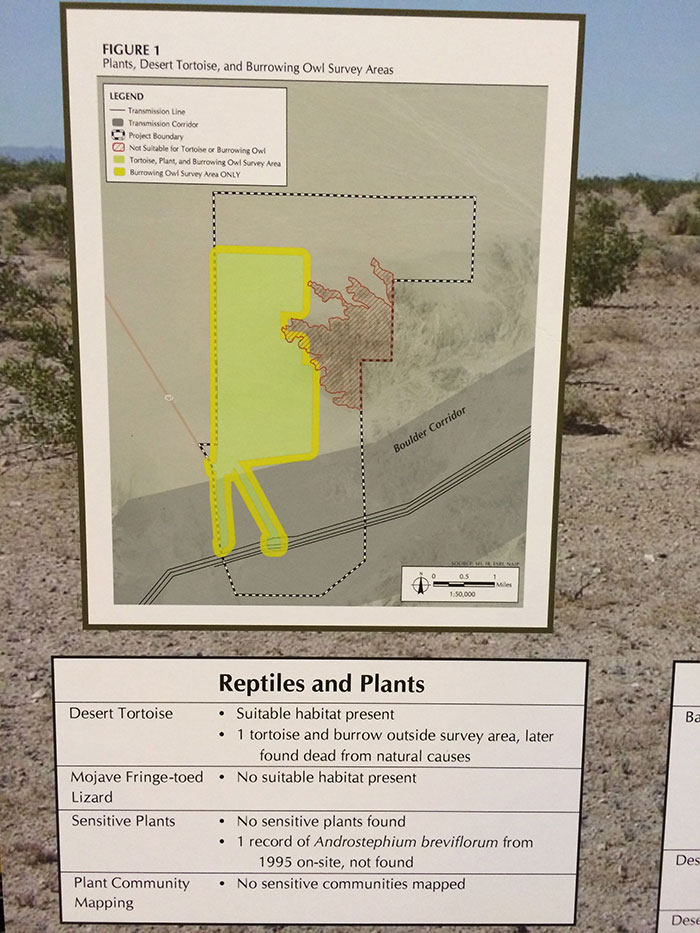
Carol Wiley, a long-time resident in the Mojave Desert, said the Silurian Valley is gorgeous. That "nothing there" is not true -- the area is full of wildlife and is a migration corridor.
Kevin Emmerich of Basin & Range Watch commented that dust issues have not been adequately addressed in other solar energy projects, and that we only support rooftop solar or brownfields by urban areas. Simply moving a large-scale energy project to other desert ecosystems in Solar Energy Zones is not going to solve the problems of fragmentation in the unique California Desert Conservation Area. We do not support Solar Energy Zones or Variance Areas for development of renewable energy.
Barstow city planner Viola Basuto commented that the Barstow people do care about their desert -- the desert is being torn up due to unwise planning. Tourism is important. She noted that Chinese tourists, for instance, want their picture taken next to Silurian Valley -- this vast "Nothing". They tell her they they do not have a lot of "Nothing" where they are from. "Be appreciative of your 'Nothing'", they say. She told the room that she looks to the wisdom of "Afford-ability now, sustainability for later."
Two people in the afternoon session supported the applicant citing climate change concerns and economic development opportunities and jobs.
Comment to BLM
As a follow-up to this meeting, we suggest that we persuade our desert-loving friends and colleagues to write letters to state and national BLM, including our congressional representatives, demanding that the democratic public process be restored by recording the public’s verbal comments. Many people reiterated the point that some of us drove more than 300 miles to attend the meeting and it is not fair to deny them the right to be officially heard and recorded into the public record. We can also tell them that Silurian Valley is not an appropriate place to develop solar power plants.
DEADLINE EXTENDED to May 28, 2014.
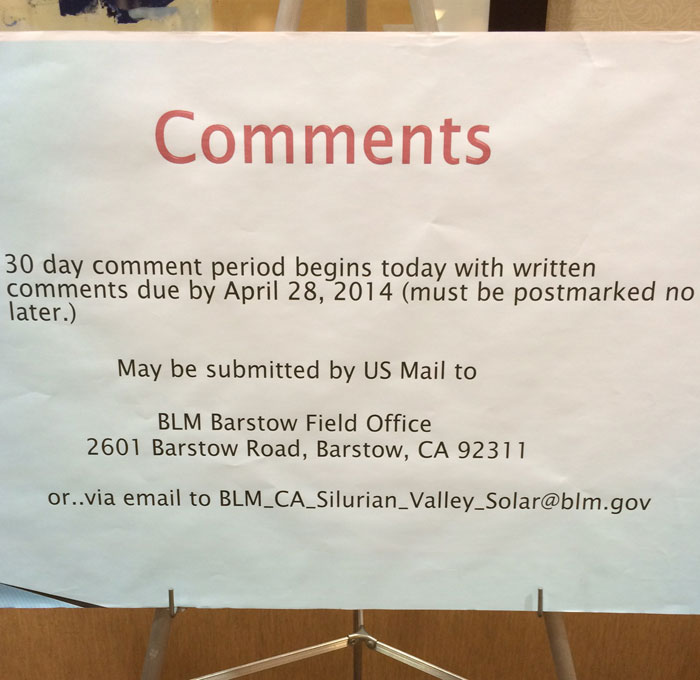
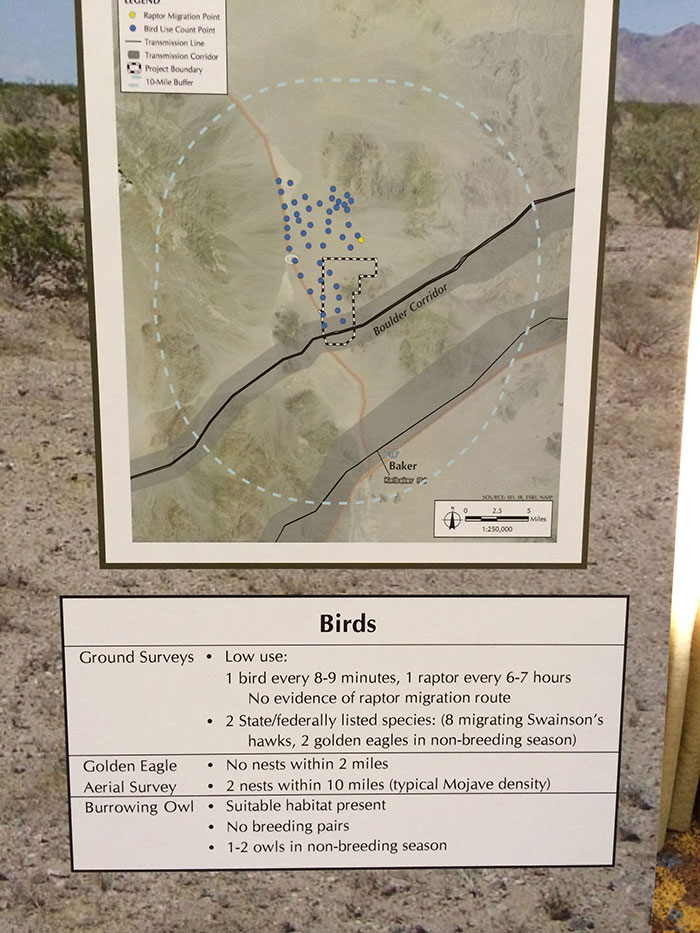
Thank you to Terry Weiner for sharing her notes with me to prepare this report -- Laura Cunningham.
Bureau of Land Management to Hold Public Meeting on Solar in Silurian Valley
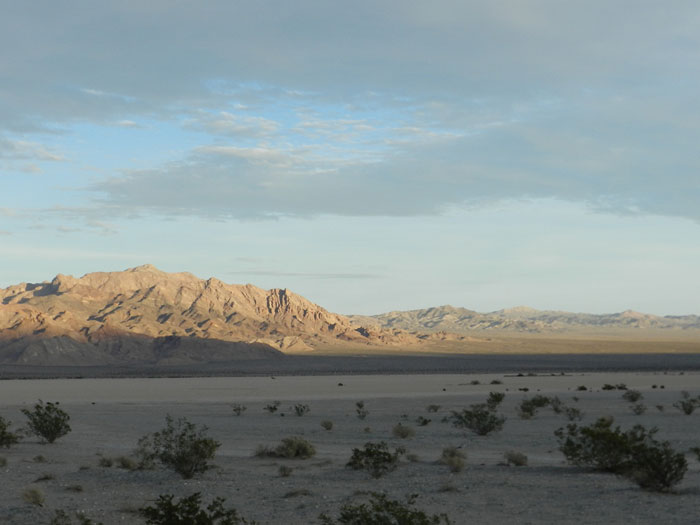
March 10, 2014 - On Thursday, March 27, 2014, the BLM will conduct a public meeting to solicit comments from public agencies and the general public about their concerns and interests on the proposed Silurian Valley solar project. Representatives from Aurora Solar, LLC, a subsidiary of Iberdrola Renewables, Inc., will be present for general questions. The meeting will be held at the Hampton Inn & Suites, 2710 Lenwood Road, Barstow, California from 1:30-4:30 p.m. and 6:00-9:00 p.m. If you have questions about this public meeting, please contact Joan Patrovsky, BLM Realty Specialist at (760) 252-6032. The see notice pdf >>here.
Take Action to Conserve Silurian Valley
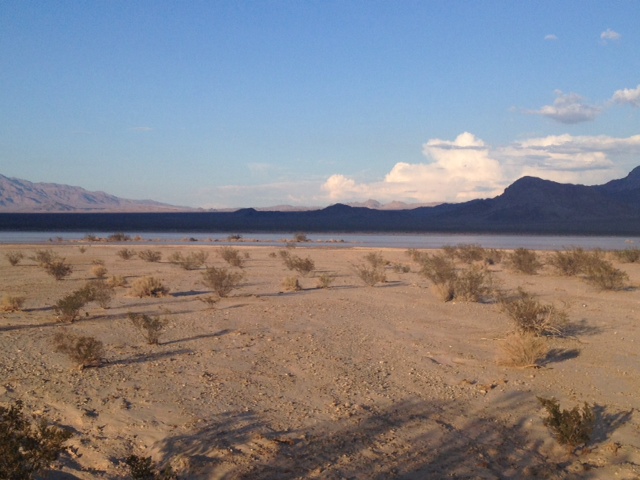
^Silurian dry lake after torential monsoon rains in August flooded the basin. The playa was muddy when we took this sunset photo.
September 15, 2013 - The wild Silurian Valley has become a target for both wind and solar development, but the public has an opportunity to recommend this area as a conservation zone instead. The Mojave Desert Blog has good instructions for how to do this:
Under the Desert Renewable Energy Conservation Plan, the Bureau of Land Management and California Energy Commission are identifying areas in the desert where energy development will be allowed, known as "development focus areas." These agencies are considering designating the Silurian Valley as one of these development areas, but we also have an opportunity to speak up and identify the places we would like to protect for future generations.
See the blog for more:
http://www.mojavedesertblog.com/p/take-action-for-silurian-valley.html
Mojave Desert Southeast of Death Valley National Park

April 8, 2013 - Download the Plan of Development for the proposed Silurian Valley Solar Project which would be located on a 7,218 Right of Way north of Baker, California.
The updated plan is for a 200 MW photovoltaic facility consisting of thin-film solar panels.
From the Plan of Development: "Aurora Solar, LLC, (Aurora Solar), a wholly owned subsidiary of Iberdrola Renewables, LLC., requests a right-of-way (ROW) grant to construct, operate, maintain, and decommission a solar energy generation facility with a maximum generating capacity of 200 megawatts (MW) in northeastern San Bernardino County, California. The proposed Silurian Valley Solar Project (the Project) is within a 7,218-acre ROW (the project ROW) located on federal land under the jurisdiction of the U.S. Department of the Interior’s (DOI’s) Bureau of Land Management (BLM) within the jurisdiction of the Barstow Field Office (FO) (Figure 1). Aurora Solar has prepared this Plan of Development (POD) as part of the ROW application for the project."
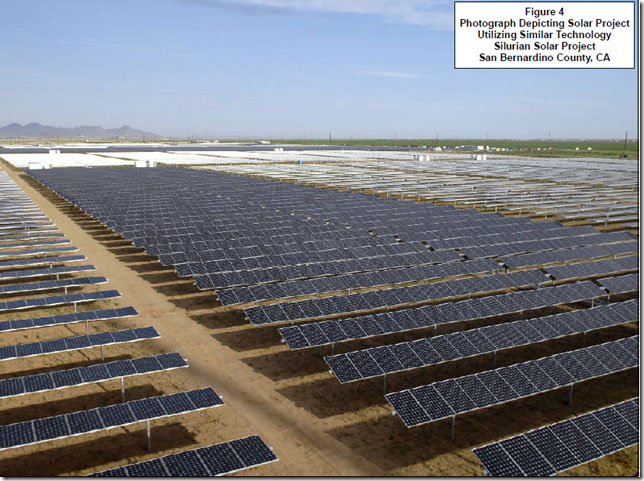
^The visual simulation of the Silurian Valley Solar Project from the Aurora Solar LLC Plan of Development. The Thin-Film Photovoltaic design usually requires 100 percent grading of vegetation.
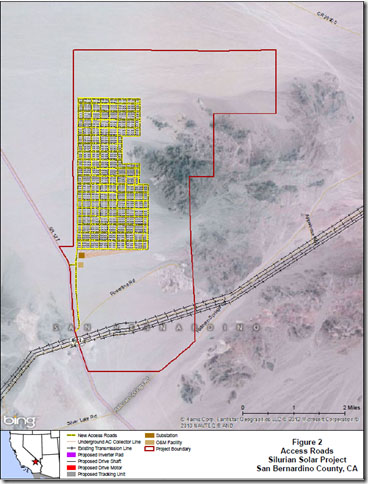
^The map of the proposed Silurian Valley Solar Project from the Aurora Solar LLC Plan of Development.
January 20, 2013 - According to the Bureau of Land Management (BLM), Iberdrola has reconfigured this project to be a combination wind and solar facility. Of the 29,000 acres Iberdrola would like to industrialize, they have decided to consider 10,000 acres of the project for a utility scale photovoltaic project. So it would be a combination of a wind energy and solar project. However, according to another BLM individual, Iberdrola would like to retain the wind project application in its existing location and develop an additional solar farm on public lands to the south. Indeed, Iberdrola does have an additional application to construct a solar facility on 7,000 acres of public land just south of the Silurian Wind Project application. The latest map of renewable energy applications in California can be viewed >>here.
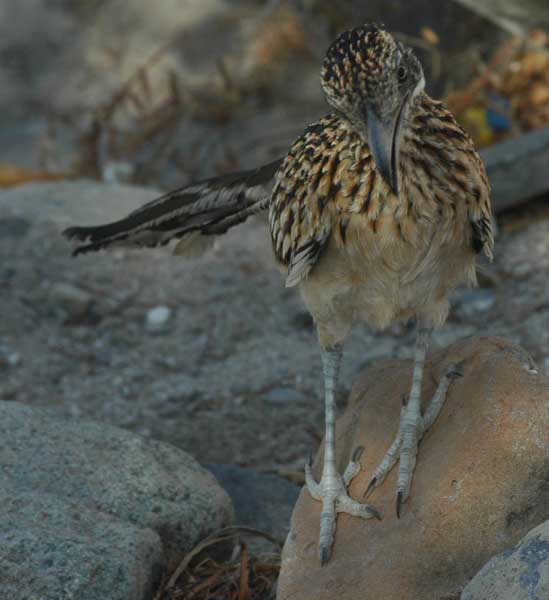
^Roadrunners (Geococcyx californianus) are common on the project site.
The Department of Defense (DOD) expressed concern over this project because giant wind turbines can disrupt radar. Radar technology is designed to detect moving objects. Spinning wind turbine blades can create interference which degrades the signal. Wind towers carry a signal strength greater than a Boeing 747, so when the radar repeatedly sees the large return it cannot detect actual aircraft in the same area. In a comment on California's Desert Renewable Energy Conservation Plan, the DOD has expressed concern to the Interior Department that they are working too fast to site wind energy in Military Red Zones which a scattered throughout public lands. These are zones where pilots and others conduct training and testing for military operations. Since the Silurian Valley Wind Project would be built in one of these Red Zones, Iberdrola has reconfigured the project to include solar energy so they can avoid conflicts with the military. We have requested the new map from the BLM. So far, Iberdrola has no Power Purchase Agreement with any utility for this project and the environmental review is not ready yet.
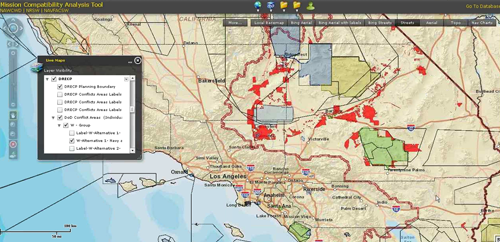
^Military Red Zones, California Desert
More information on the Military Red Zones can be found on the Mojave Desert Blog >>here.
^Sunset looking south towards the project site from the Salt Creek Hills Area of Critical Environmental Concern. The wind farm would be a visual resources disaster.

^December 2012 map of the new wind farm configuration
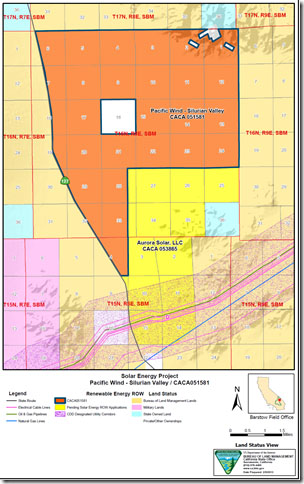
^BLM map of both the wind and solar project applications
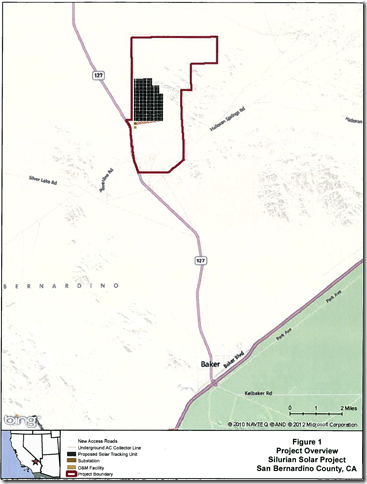
^Map of the Iberdrola Solar Farm application
August 22, 2011 - Pacific Wind Development LLC, a subsidiary of Iberdrola Renewables, is requesting a right-of-way (ROW) grant to construct a wind energy generation facility with a maximum generating capacity of 200 megawatts (MW) in northeastern San Bernardino County, California. The proposed Silurian Valley Wind Energy project is within a 29,041 -acre ROW on federal land under the jurisdiction of the Bureau of Land Management (BLM) within the Barstow Field Office. The project would have 80 to 133 Wind Turbine Generators, up to 480 feet tall each. A new 115 or 230 kilovolt transmission line would need to be built for 10 miles to connect to the Baker substation.
^This view of the Shadow Mountains would be blocked by big turbines, solar panels and transmission lines.
The proposed project is in a remote creosote-filled basin with playas located north of Baker, along Highway 127, south of Dumont Dunes. The project is on the boundary of both the Hollow Hills and Kingston Range Wilderness Areas.
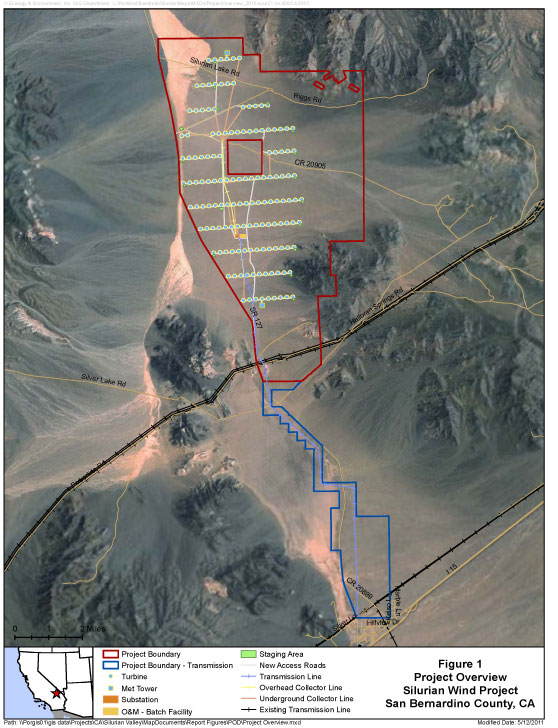
Download the Plan of Development - 12.6 MB PDF.
18,000,000 gallons of water would be needed for cement making during constrcuction for foundations, and the water may come from on site.
The region around the project site supports Desert tortoise (Gopherus agassizii). Golden eagles (Aquila chrysaetos), Burrowing owls (Athene cunicularia), and other sensitive species are potentially in the area. Mohave ground squirrel (Xerospermophilus mohavensis) may possibly live in the region. The rare plant Small-flowered androstephium (Androstephium breviflorum) has been mapped in the area.
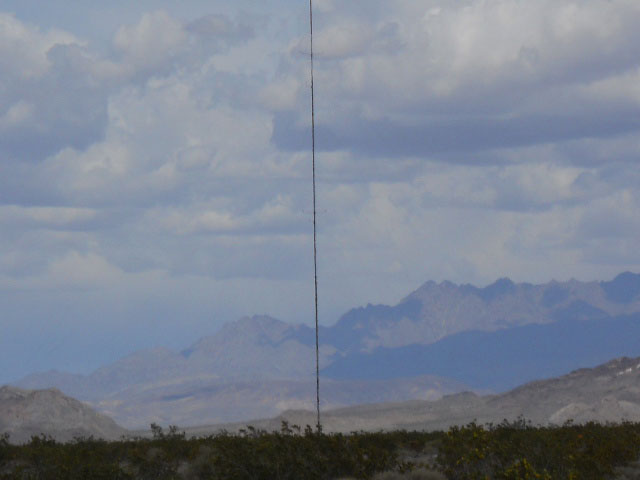
^Meteorological tower at the proposed project site in Silurian Valley.
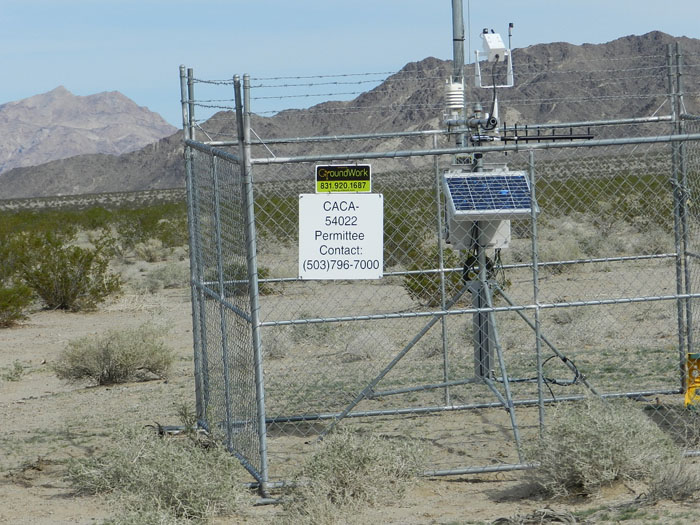
^ Iberdrola's solar meteorological test station
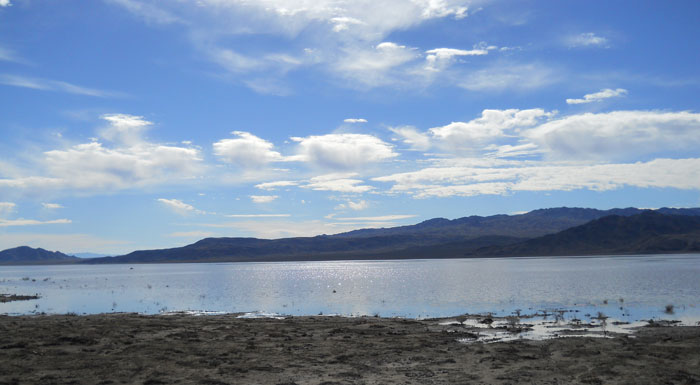
^Near the Silurian Valley wind project area is Silver Lake, normally a dry playa but this spring heavy rains filled it. The temporary lake attracted numerous waterbirds, including American white pelicans.
^Avawatz Mountain seen looking west from the project site.
^South Soda Mountains, Mojave National Preserve. Looking north towards the project site beyond the town of Baker, California.
^Looking south towards the project site from the Salt Creek Hills Area of Critical Environmental Concern. Do we want to conserve public lands for future generations or replace them with poorly sited industry and energy sprawl? Renewable energy belongs in the built environment and on degraded lands.
Beautiful Silurian Valley
February 14, 2014 - This vast remote valley is surrounded by mountain ranges and Wilderness Areas. Proposals for large-scale renewable energy developments in the place are inappropriate. Better alternatives are available such as rooftop solar in cities.

^Sunset on the playa in Silurian Valley looking eastwards.
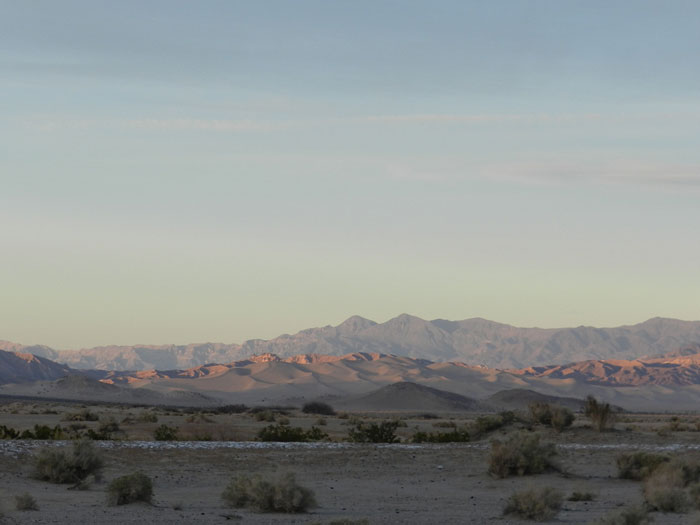
^Sunset looking northwards towards the Dumont Dunes.
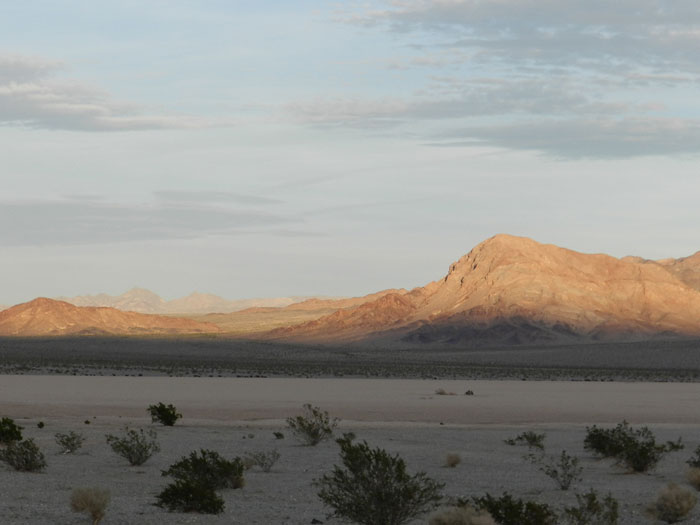
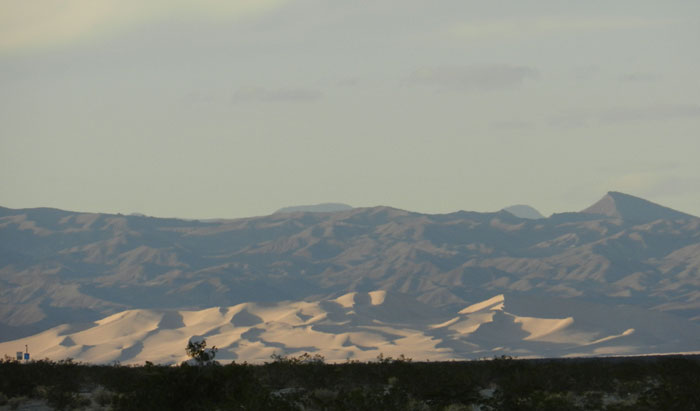
^Dumont Dunes.
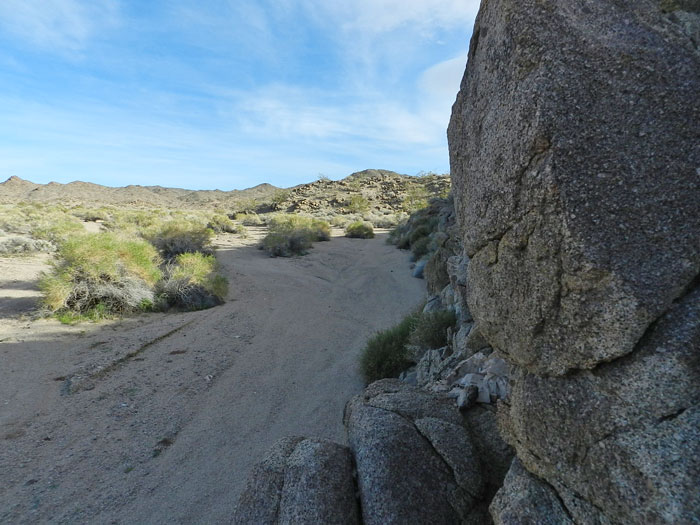
^Hollow Hills Wilderness Area on the southeast side of Silurian Valley next to the propoased giant wind and solar project. This area received enough rains in winter to green up the desert shrubs and a few wildflowers.
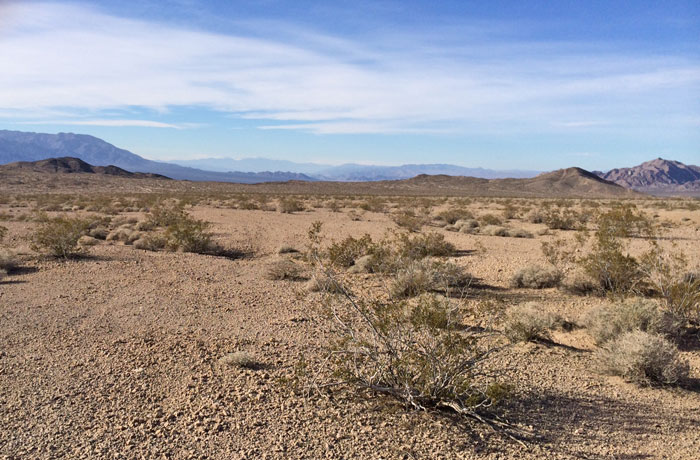
^Hollow Hills Wilderness looking westward towards Silurian Valley.
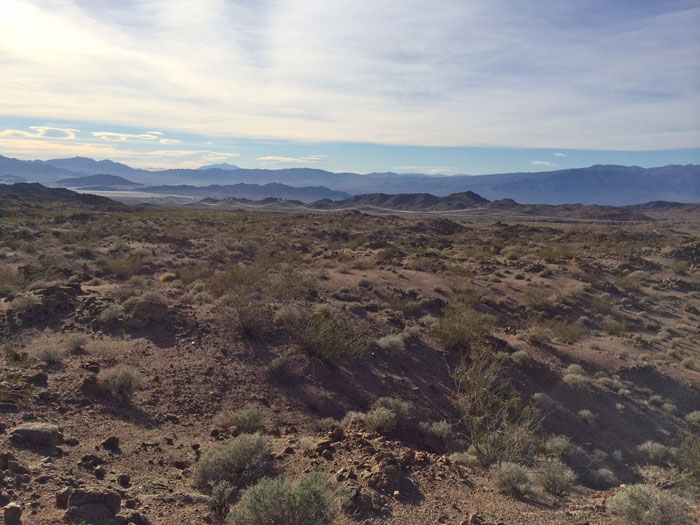
^A transmission line in the distance is what attracts renewable energy developers to this wild remote land.

^Hollow Hills Wildernss granitic hills and washes.
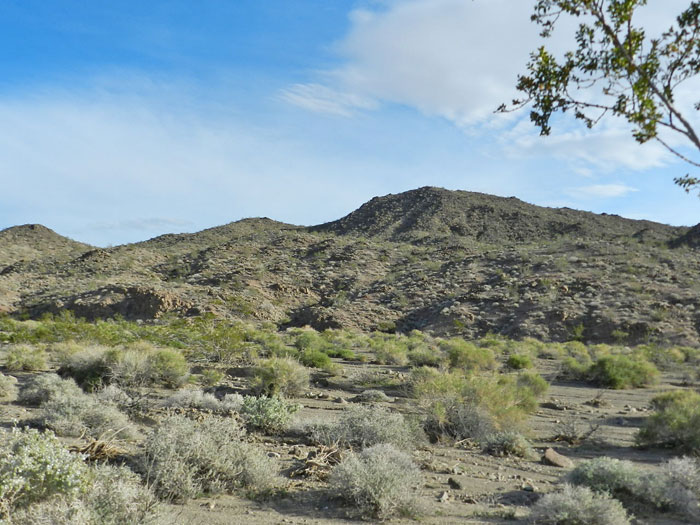
^Hollow Hills Wilderness.
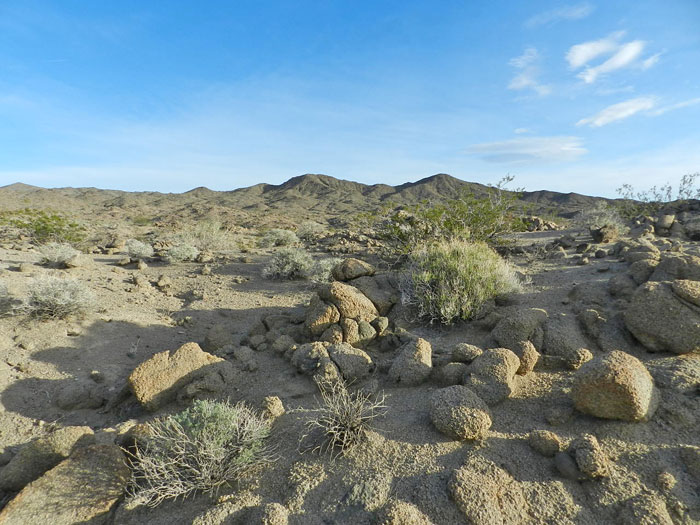
^Hollow Hills Wilderness.
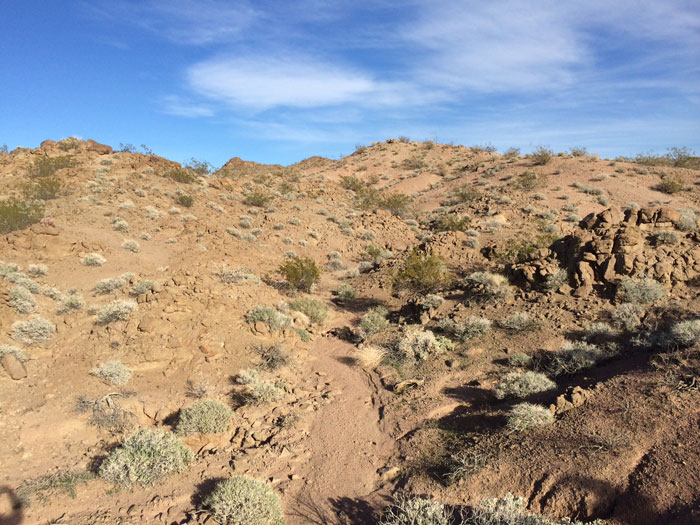
^Hollow Hills Wilderness.
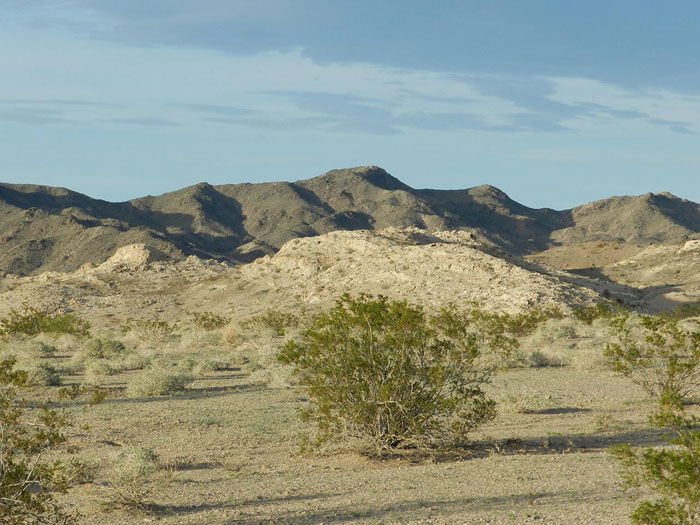
^Hollow Hills Wilderness.
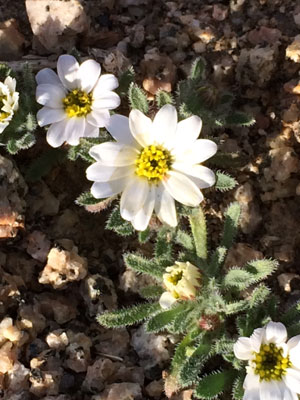
^Mojave desert star (Monoptilon bellioides) blooming in February 2014.
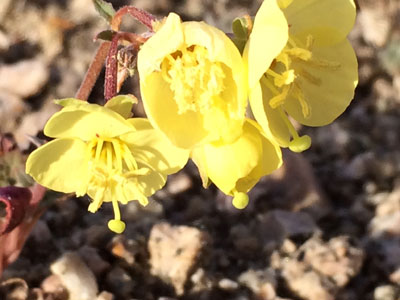
^Golden evening primrose (Chylismia brevipes).
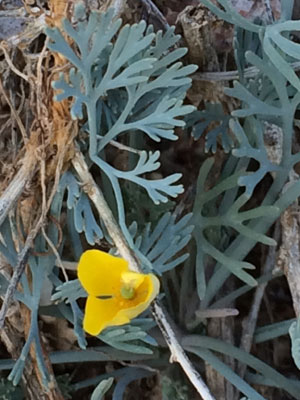
^A minute poppy (Eschscholzia sp.)
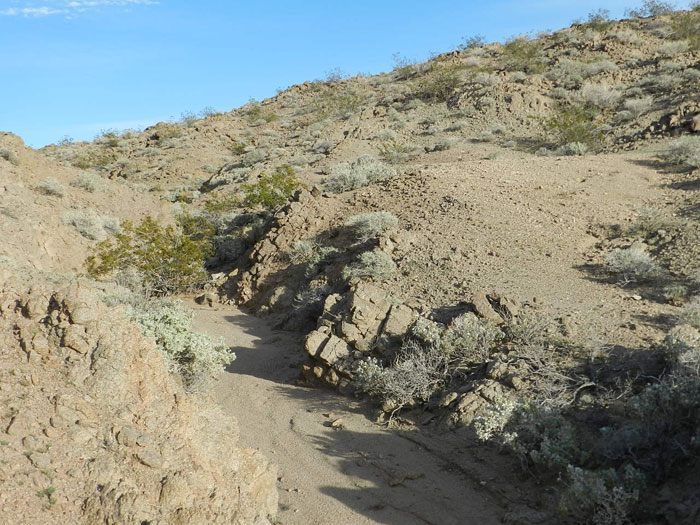
^Hollow Hills Wilderness.
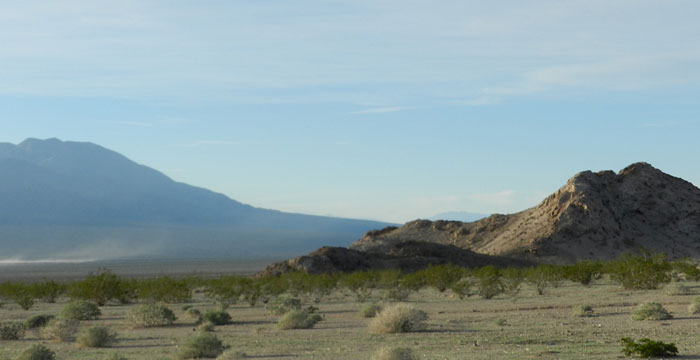
^Dust blows off a playa in Silurian Valley, as seen from the Hollow Hills Wilderness.
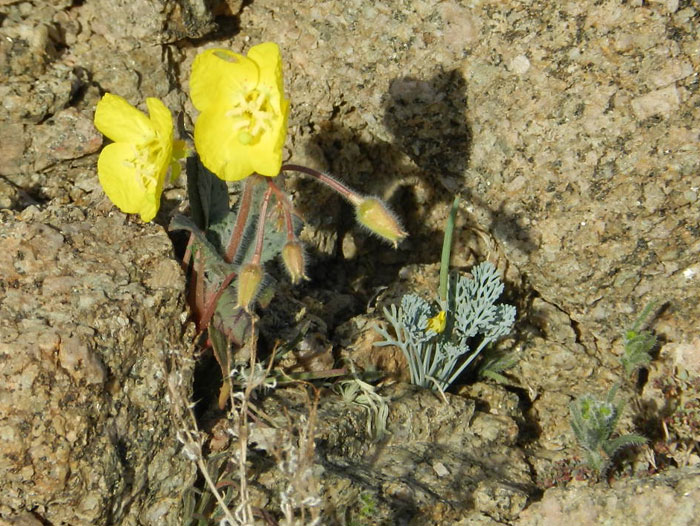
^Golden evening primrose and poppy.
